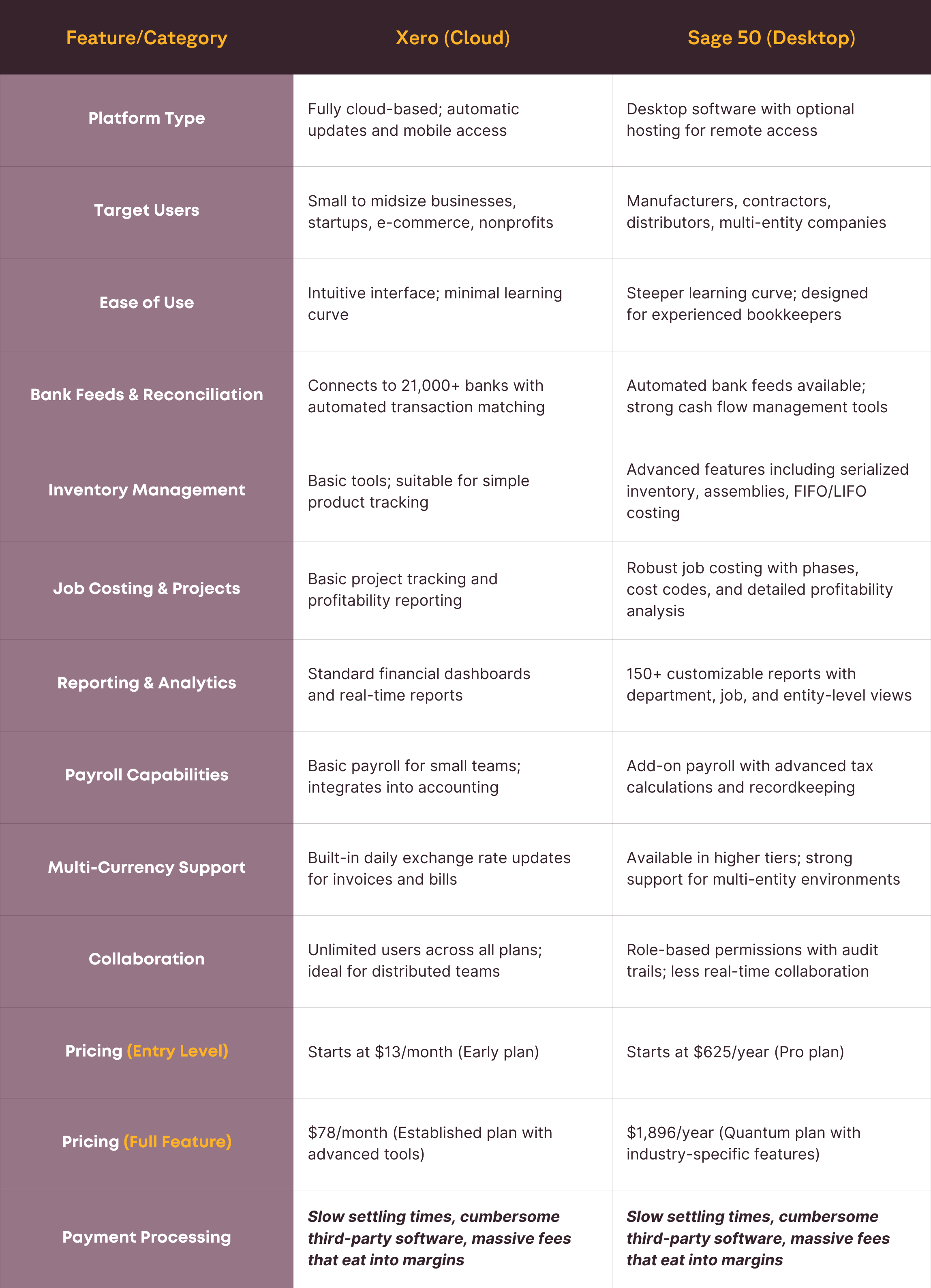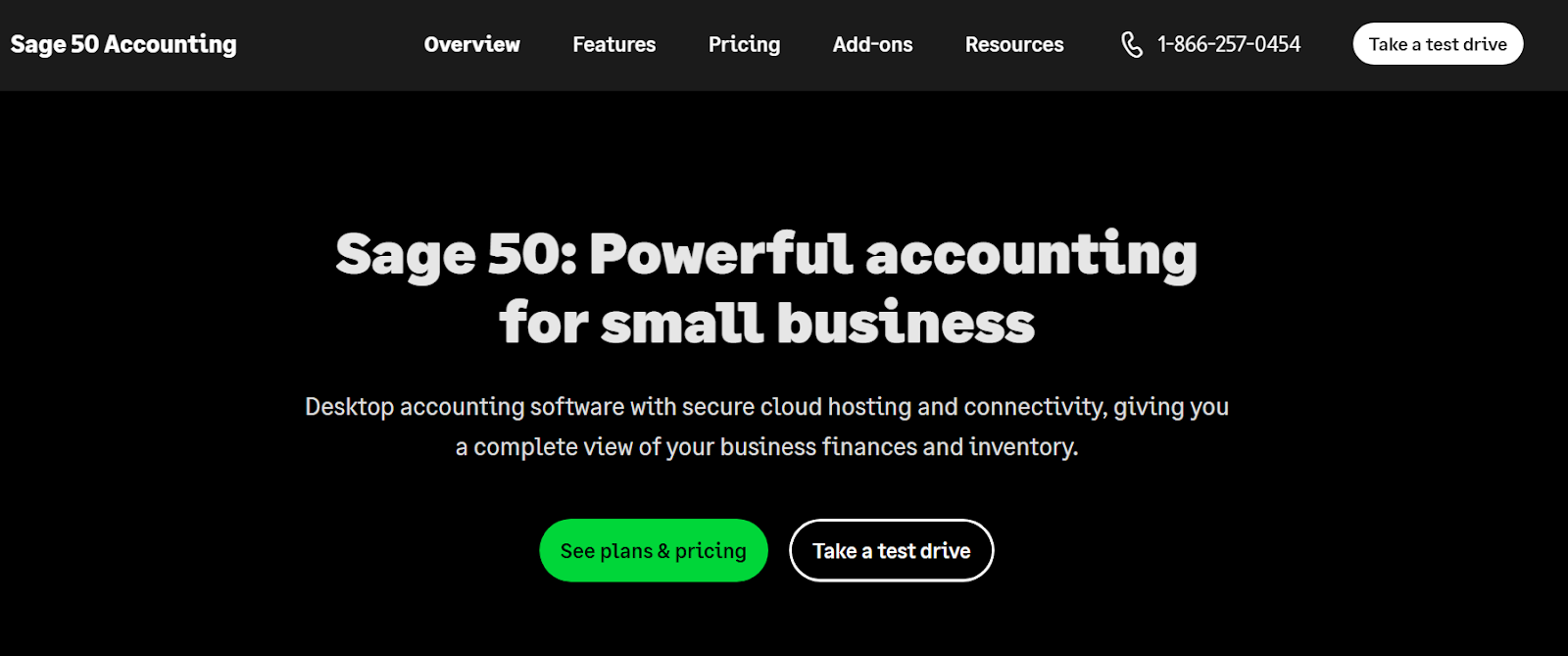Accounting software shouldn’t make your life harder, but picking the right one often feels like flipping a coin. Xero and Sage 50 are two of the biggest names in the game, and on paper, both seem like no-brainers.
They handle invoicing, reporting, payroll, and more - basically everything you need to keep your books clean.
In this guide, we’re going head-to-head on Xero vs. Sage 50 to compare their accounting features. You’ll see where each shines, where they fall flat, and which one actually deserves your money.
Then we’ll tackle the part nobody talks about: why both tools charge way too much for sending and receiving payments, and how you can fix it without ditching your current accounting software.
Spoiler: there’s a better way to pay, such as with payment platforms like Nickel that offer free ACH transfers and QuickBooks-native integration, and we’ll show you how.
Key Takeaways
- Xero is a modern cloud platform with automated bank feeds, real‑time reporting, and unlimited users starting at $13 per month.
- Sage 50 is a powerful desktop solution ideal for manufacturers and contractors needing advanced inventory and job costing, starting at $625 per year.
- Both platforms cover invoicing, payroll, and multi‑currency support but cater to different business needs and workflows.
- Payment processing is a weak spot for both, relying on Stripe or PayPal with ACH fees around 0.8% and credit card fees at 2.9% or higher.
- The Nickel payment platform offers 100% free ACH transfers, compliant credit card surcharging, and QuickBooks Online integration to fix the payment gap.
- Start using Nickel today to cut fees, simplify workflows, and keep your accounting clean without changing your current software.
Sage 50 vs. Xero at a Glance
Here’s a quick look at how Xero and Sage 50 stack up in terms of their accounting capabilities.

Xero: Modern Cloud Accounting

Xero has built a reputation as one of the most intuitive and scalable cloud accounting platforms for small and midsize businesses. It offers a clean interface, powerful automation, and a deep library of integrations that simplify financial management for business owners, bookkeepers, and accountants.
Because Xero is entirely cloud-based, there’s nothing to install, and updates happen automatically. It connects to over 21,000 banks worldwide for seamless data syncing, and its mobile app allows you to manage finances on the go.
This flexibility has made Xero a favorite for service-based businesses, e-commerce brands, and even nonprofits that need straightforward, reliable accounting without heavy IT involvement.
Core Accounting Features
Xero covers the full accounting cycle from daily transaction tracking to year-end reporting, with features designed to reduce manual work and keep financial data accurate. Here’s a closer look at what stands out:
Automated Bank Feeds and Reconciliation
Xero connects with over 21,000 financial institutions worldwide, pulling transactions into your account automatically. Once imported, its smart reconciliation engine suggests matches between bank transactions and your recorded invoices, bills, or expenses. You can set up custom bank rules to handle recurring transactions, which speeds up monthly closings and minimizes errors.
Professional Invoicing and Quotes
Create branded invoices and quotes that look professional and can be customized with your logo, payment terms, and itemized line entries. You can send invoices directly via email or share links for faster turnaround. Recurring invoices are supported for subscription-based businesses, and automatic reminders help cut down on late payments without constant follow-up.
Expense and Bill Management
Xero centralizes all expense claims and accounts payable. Employees can upload receipts via the mobile app, categorize spending, and submit claims for approval. On the vendor side, you can schedule bill payments, track outstanding liabilities, and forecast cash flow based on upcoming due dates.
Inventory and Fixed Asset Tracking
For product-based businesses, Xero includes basic inventory tools that track quantities, assign items to invoices, and generate reports on stock levels and value. It also allows you to manage fixed assets, calculate depreciation automatically, and keep an updated asset register for tax reporting.
Payroll and Employee Records
While Xero’s payroll capabilities are more limited than specialized payroll software, it supports basic pay runs for a small number of employees. You can manage timesheets, record pay rates, generate pay slips, and run payroll reports. Integration with Xero’s accounting tools ensures wages and taxes flow directly into your general ledger.
Multi-Currency Support
Businesses dealing with international suppliers or customers can manage multiple currencies within Xero. The system automatically updates exchange rates daily and applies them to invoices, bills, and reports, reducing the need for manual currency conversions.
Project and Job Costing
Xero’s Projects feature allows you to budget, quote, and track job costs in real-time. You can log billable time and expenses, compare estimated versus actual costs, and analyze profitability by project. This is particularly useful for service businesses like agencies, contractors, or consultancies.
Reporting and Financial Dashboards
Xero includes a wide range of pre-built financial reports - profit and loss, balance sheet, cash flow, and aged receivables/payables - as well as interactive dashboards for daily oversight. While customization options are somewhat limited, the built-in analytics cover most small business needs and provide real-time visibility into financial health.
Xero Pricing
Xero offers three main subscription tiers in the U.S., making it adaptable to different business sizes and needs:
- Early Plan - $13/month: Best for freelancers or very small businesses with limited transactions.
- Growing Plan - $37/month: Suitable for growing small businesses managing ongoing invoices, bills, and reconciliations.
- Established Plan - $78/month: Includes advanced features like multi-currency support, project tracking, and expense management.
All plans include unlimited users, which is a major advantage for teams that need multiple people, such as accountants and managers working in the same system.
Xero Strengths
- Clean, intuitive interface with minimal learning curve
- Strong automation for reconciliation and reporting
- Unlimited users across all pricing tiers
- Over 1,000 app integrations for customization
- Reliable bank syncing and robust multi-currency tools
Xero Weaknesses
- Payroll features are limited compared to specialized platforms
- Inventory tools may not suit complex product businesses
- Reporting customization can feel restrictive for advanced users
- No offline functionality - requires constant internet access
Sage 50: Comprehensive Desktop Accounting

Sage 50, formerly known as Peachtree Accounting, has long been recognized as one of the most robust desktop accounting solutions for small and mid-sized businesses. It’s a platform built for companies that prioritize deep financial control, detailed reporting, and advanced functionality over cloud convenience.
Manufacturers, contractors, and distributors in particular appreciate Sage 50’s mature toolset, especially when managing complex inventory and job costing requirements.
While newer cloud tools like Xero and QuickBooks Online dominate headlines, Sage 50 remains a reliable option for businesses that prefer to host their data locally or work in industries where offline access is crucial. It offers a strong mix of traditional accounting workflows and modern enhancements like bank feeds and Microsoft 365 integration, making it appealing for teams that want advanced features without moving everything to the cloud.
Core Accounting Features
Sage 50’s core strength lies in its depth. It’s not designed for beginners but rewards experienced bookkeepers and accountants with granular control over every part of the financial process.
Advanced Inventory Management
Sage 50 supports detailed inventory tracking, including serialized and lot-based items, assemblies, and multiple costing methods like FIFO, LIFO, and Average Cost. This makes it well-suited for product-based businesses with complex stock requirements. You can manage reorder points, track stock levels across multiple locations, and generate specialized inventory reports for better purchasing decisions.
Job Costing and Project Tracking
Job costing is one of Sage 50’s best features. Users can create jobs with multiple phases and cost codes, track labor and materials against those jobs, and compare estimated versus actual costs in real-time. This level of detail is especially valuable for construction firms, contractors, and other service providers that need precise profit tracking at the project level.
Comprehensive Reporting and Budgeting
The platform includes over 150 pre-built financial reports, with customization options to tailor them by department, job, or time period. Advanced users can create report groups, run batch reports, and drill down from summary data into underlying transactions. Budgeting tools allow you to forecast revenue and expenses at a granular level and compare performance against actuals.
Multi-Company and Multi-Entity Support
Sage 50 allows multiple company files to be managed from one installation, making it efficient for accountants or business owners running several entities. Role-based permissions and audit trails ensure financial control and compliance across different teams or locations.
Cash Flow and Bank Reconciliation
Built-in cash flow management tools give users a clear view of incoming and outgoing funds, enabling proactive decision-making around expenses and payables. Automated bank feeds and reconciliation tools reduce manual entry, helping maintain up-to-date and accurate books.
Payroll and Employee Management
While payroll is offered as an add-on rather than included in every plan, Sage 50’s payroll tools are tightly integrated with the core accounting system. Users can process pay runs, manage tax calculations, and maintain employee records without leaving the software.
Industry-Specific Editions
For construction, manufacturing, and distribution, Sage 50 offers specialized versions with features like change order tracking, production management, and advanced cost allocation. These industry editions provide functionality not typically found in cloud-first competitors, making Sage 50 attractive to businesses with specialized accounting needs.
Sage 50 Pricing
Sage 50 is sold via annual subscription, with three primary editions:
- Pro Accounting - $625/year: Suitable for solopreneurs or small businesses with basic accounting needs and single-user access.
- Premium Accounting - $1,100/year: Adds features like advanced inventory, job costing, and up to five users.
- Quantum Accounting - $1,896/year: Full-featured edition supporting up to 40 users and industry-specific capabilities for construction, manufacturing, and distribution.
Payroll can be added to any plan for an additional cost, starting at $1,043/year for Pro with payroll. Hosting services are also available for businesses wanting remote access without giving up desktop functionality.
Strengths
- Deep accounting functionality suitable for complex industries
- Robust inventory and job costing tools
- Customizable reporting and strong audit controls
- Multi-company management in one installation
- Offline access and local data ownership for higher control
Weaknesses
- Desktop-only environment limits real-time collaboration
- Steeper learning curve compared to cloud competitors
- Higher upfront pricing, especially for multi-user setups
- Requires manual updates and local IT maintenance unless hosted
Which Solution Matches Your Business Needs?
Choosing between Xero and Sage 50 is about which aligns with your workflow, your team’s skill set, and how much control you want over your books. Both platforms nail the accounting fundamentals but serve very different audiences.
Xero Accounting Is Best For
Xero is tailor‑made for modern small to midsize businesses that live in the cloud. If you value real‑time collaboration with your accountant, automated bank feeds, and mobile access from anywhere, Xero delivers. It’s especially popular with:
- Service‑based businesses like agencies and consultancies
- E‑commerce brands that need integrations with online sales channels
- Startups and nonprofits looking for simple setup and easy scalability
Its clean interface and unlimited user access make it ideal for teams without in‑house IT support who still want professional‑grade accounting tools.
Sage 50 Accounting Is Best For
Sage 50 is the heavyweight option for companies with complex financial needs and a preference for desktop control. If you manage detailed inventory, multi‑phase job costing, or industry‑specific compliance requirements, Sage 50’s depth is unmatched. It’s well‑suited for:
- Construction firms juggling multiple projects and cost codes
- Manufacturers and distributors tracking serialized inventory
- Multi‑entity businesses needing robust audit trails and advanced reporting
For teams comfortable with traditional software and who want local data storage for security or regulatory reasons, Sage 50 provides power and precision cloud tools can’t match.
But Neither Is Ideal For Payments
Here’s where both platforms stumble: payments. Xero and Sage 50 handle accounting beautifully but outsource payment processing to third parties like Stripe or PayPal.
That means extra portals to manage, slower workflows, and transaction fees that quickly add up, especially on large B2B invoices or recurring vendor payments.
For companies that move high‑volume transactions every month, those fees quietly erode margins.
Modern businesses often need accounting and payments working together, not bolted on as an afterthought, which is exactly where alternatives like purpose‑built payment platforms step in.
Where Xero and Sage 50 Accounting Software Falls Short: Cumbersome and Expensive Payments
Both Xero and Sage 50 shine when it comes to core accounting functions like reconciliation, reporting, and inventory tracking. But when businesses need to actually send or receive money, whether paying vendors or collecting on invoices, these platforms start to show their cracks.
Neither offers a built‑in payment system. Instead, they lean on third‑party processors like Stripe or PayPal, which means businesses face extra complexity and sky‑high transaction fees.
For companies moving significant sums every month, these costs quietly erode margins. High‑volume B2B invoices, frequent ACH transfers, or international payments can turn what seems like a convenient feature into an expensive bottleneck.
The Hidden Cost of Xero’s Stripe Integration
Xero doesn’t process payments directly. When customers pay through an invoice’s “Pay Now” button, they’re routed to Stripe, which handles the transaction. While the integration keeps accounting records tidy - payments are auto‑matched to invoices - Stripe’s fee structure makes this convenience costly:
- ACH (Bank Transfers): 0.8% per transaction, capped at $5
- Credit Cards (Domestic): 2.9% + $0.30 per transaction
- International Cards: Additional 1.5% surcharge
- Currency Conversion: Additional 1%
- Manual Keyed Entry: Additional 0.5%
Even capped ACH fees add up fast for companies processing dozens of payments each month. And large card payments can be punishing - a single $50,000 transaction could cost more than $1,450 in fees.
Find out how to avoid costly stripe fees right here.
Sage 50’s Payment Options: Two Platforms, Same Problem
Sage 50 users face similar challenges. The desktop software doesn’t handle payments natively, forcing businesses to integrate Stripe or PayPal for invoice collection. Both options pile on fees, and neither is seamless within Sage 50’s desktop environment:
Stripe via Sage 50
- ACH Transfers: 0.8% per transaction, capped at $5
- Domestic Cards: 2.9% + $0.30 per transaction
- International Cards: Additional 1.5%
- Currency Conversion: Additional 1%
- Manual Entry: Additional 0.5%
PayPal via Sage 50
- ACH Transfers: 0.75% per transaction, capped at $5
- Credit/Debit Cards (Guest Checkout): 2.99% + $0.49 per transaction
- Additional surcharges depending on merchant agreement
For businesses in industries like construction, distribution, or manufacturing, where five‑ and six‑figure payments are common, these fees eat into profits and create unnecessary administrative overhead.
Using Nickel to Solve the Payment Problem
Xero and Sage 50 crush it when it comes to accounting. They handle invoicing, reporting, and reconciliations like pros. But when it’s time to actually send or receive money? That’s where things fall apart.
Both platforms rely on third‑party processors like Stripe or PayPal, which means two things: extra logins and sky‑high transaction fees that quietly drain your margins.
This is exactly where Nickel comes into play. Nickel is a purpose‑built payment platform with 100% free and unlimited ACH transfers - no caps, no fine print.
You can also pass credit card fees onto customers compliantly, which means your business stops eating 3% every time someone pays via credit card. For companies handling big invoices or frequent transfers, that’s thousands of dollars saved every month.
Keep Your Accounting Platform – Upgrade Your Payments
Here’s the best part: you don’t have to ditch Xero or Sage 50 to fix your payment headaches. Keep using whichever accounting software your team already knows. Just stop using it to process payments and start using Nickel.
By routing all ACH and card transactions through Nickel instead, you bypass the slow settlement times and monster fees that come with Stripe or PayPal.
Your books stay clean, your reconciliations stay accurate, and you put real money back in your pocket instead of handing it to processors. Read more about the best payment provider for small businesses right here.
Why Nickel + QuickBooks Online Is a Killer Combo
If you’re already running QuickBooks Online, or considering switching from Xero or Sage 50 to QuickBooks Online, Nickel takes things up another notch.
It integrates natively with QuickBooks, syncing invoices, bills, and payment data in real-time. No CSV uploads, no batch matching, no manual entry. Every transaction flows automatically into your ledger, down to the exact chart of accounts.
That means you can manage payments and accounting from one connected system while enjoying free ACH transfers and flexible credit card surcharging.
And if you’re not ready to leave Xero or Sage 50? No problem. Nickel works as a standalone payment engine, giving you all the cost savings and speed without forcing you to overhaul your accounting stack - Nickel features 100% free and unlimited ACH transfers.
Nickel essentially lets you fix the most expensive part of your financial workflow - payments - without the pain of switching everything else. Learn more about the best way for businesses to accept large payments in this guide.
Xero vs. Sage 50: Final Thoughts
Xero and Sage 50 each deliver serious accounting power, but neither solves the biggest pain point for most businesses: expensive, slow payment processing. Both platforms excel at keeping your books clean, automating reconciliation, and managing everything from inventory to job costing.
The problem is that their reliance on third‑party payment tools like Stripe or PayPal adds complexity and massive fees that erode profit margins.
Nickel solves that gap. By offering unlimited free ACH transfers, credit card surcharging, and QuickBooks Online integration, Nickel eliminates payment headaches without forcing you to abandon your current accounting platform. If you want reliable accounting and low‑cost payments, pairing your preferred software with Nickel is the smarter, more cost‑effective move.
Create a free Nickel account and start processing unlimited free ACH transfers today, all while maintaining clean books thanks to native QuickBooks Online integration
Frequently Asked Questions
How Does Nickel Handle High-Value Transactions?
Nickel supports ACH payments up to $1 million per transaction without additional fees or surprise holds. This is especially valuable for industries like construction, wholesale, or manufacturing where large invoices are common and fast, reliable settlement is essential.
Can Nickel Work Alongside Xero or Sage 50 Without Replacing Them?
Yes. Nickel operates as a standalone payment engine. You can keep using Xero or Sage 50 for accounting while routing payments through Nickel to eliminate fees and reduce reconciliation headaches. This approach avoids major workflow changes while delivering immediate cost savings.
Is It Difficult to Integrate Nickel With QuickBooks Online?
Not at all. Nickel connects to QuickBooks Online in under five minutes with no manual data migration required. Once linked, it automatically syncs invoices, bills, and payment data, ensuring your books stay accurate in real-time without batch uploads or spreadsheets.
Does Nickel Allow Businesses to Pass Credit Card Fees to Customers?
Yes. Nickel includes compliant surcharging tools so you can shift credit card processing fees to customers when appropriate. This helps businesses protect margins without increasing prices across the board, especially for high‑ticket transactions.
What Types of Businesses Benefit Most From Nickel?
Nickel is built for small to midsize businesses that frequently send or receive large payments. Contractors, distributors, e‑commerce brands, and professional service firms save the most, especially when moving five‑ or six‑figure sums that would otherwise incur significant processing costs.
How Fast Do ACH Payments Settle Through Nickel Compared to Stripe or PayPal?
Nickel’s ACH transfers typically settle twice as fast as Stripe or PayPal. Funds move individually rather than in batches, which provides faster availability and cleaner bank reconciliation. This speed is critical for businesses managing tight cash flow or frequent vendor payments.
Don't miss these articles
Make every Nickel count
Join 10,000+ businesses paying and getting paid on Nickel



.png)


